
Braveheart is a 1995 American epic historical drama film directed and produced by Mel Gibson, who portrays Scottish warrior William Wallace in the First War of Scottish Independence against King Edward I of England. The film also stars Sophie Marceau, Patrick McGoohan, Catherine McCormack and Angus Macfadyen. The story is inspired by Blind Harry's 15th century epic poem The Actes and Deidis of the Illustre and Vallyeant Campioun Schir William Wallace and was adapted for the screen by Randall Wallace.
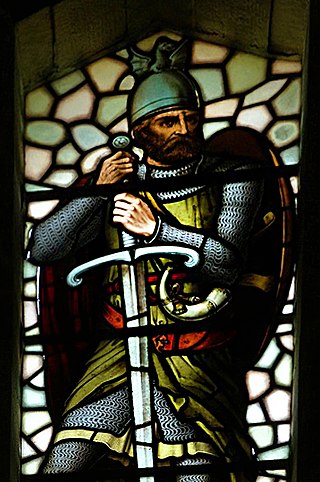
Sir William Wallace was a Scottish knight who became one of the main leaders during the First War of Scottish Independence.

The Battle of Stirling Bridge was fought during the First War of Scottish Independence. On 11 September 1297, the forces of Andrew Moray and William Wallace defeated the combined English forces of John de Warenne, 6th Earl of Surrey, and Hugh de Cressingham near Stirling, on the River Forth.
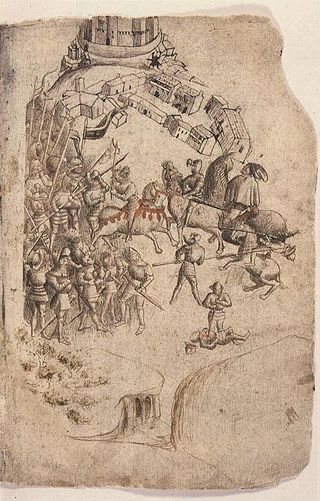
The Battle of Bannockburn was fought on 23–24 June 1314, between the army of Robert the Bruce, King of Scots, and the army of King Edward II of England, during the First War of Scottish Independence. It was a decisive victory for Robert Bruce and formed a major turning point in the war, which ended 14 years later with the de jure restoration of Scottish independence under the Treaty of Edinburgh–Northampton. For this reason, the Battle of Bannockburn is widely considered a landmark moment in Scottish history.

Blind Harry, also known as Harry, Hary or Henry the Minstrel, is renowned as the author of The Actes and Deidis of the Illustre and Vallyeant Campioun Schir William Wallace, more commonly known as The Wallace. This is a lengthy poem recounting the life of William Wallace, the Scottish independence leader, written around 1477, 172 years after Wallace's death.
Andrew Moray, also known as Andrew de Moray, Andrew of Moray, or Andrew Murray, was a Scots esquire. He rose to prominence during the First Scottish War of Independence, initially raising a small band of supporters at Avoch Castle in early summer 1297 to fight King Edward I of England. He soon had successfully regained control of the north for the absent Scots king, John Balliol. Moray subsequently merged his army with that of William Wallace, and on 11 September 1297 jointly led the combined army to victory at the Battle of Stirling Bridge. He was severely wounded in the course of the battle, dying at an unknown date and place that year.

Scottish nationalism promotes the idea that the Scottish people form a cohesive nation and national identity.
The First War of Scottish Independence was the first of a series of wars between English and Scottish forces. It lasted from the English invasion of Scotland in 1296 until the de jure restoration of Scottish independence with the Treaty of Edinburgh–Northampton in 1328. De facto independence was later established in 1314 following an English defeat at the Battle of Bannockburn. The wars were caused by the attempts of the English kings to grab territory by claiming sovereignty over Scotland while Scots fought to keep English rule and authority out of Scotland.
Sir William Crawford is a character in The Wallace, Blind Harry's epic poem about William Wallace. He appears to be an unhistorical character, although there was a Crawford family in Ayrshire at the time of the Wars of Scottish Independence, some of whom may have been Sheriff of Ayrshire.

New Cumnock is a village in East Ayrshire, Scotland. It expanded during the coal-mining era from the late 18th century, and mining remained its key industry until its pits were shut in the 1960s. The village is 5+3⁄4 miles southeast of Cumnock, and 21 miles east of Ayr.

Charles Wallace Alexander Napier Cochrane-Baillie, 2nd Baron Lamington,, was a British politician and colonial administrator who served as Governor of Queensland from 1896 to 1901, and Governor of Bombay from 1903 to 1907.
Anti-Scottish sentiment is disdain, discrimination, or hatred for Scotland, the Scots, or Scottish culture. It may also include the persecution or oppression of the Scottish people as an ethnic group or nation. It can also be referred to as Scotophobia or Albaphobia.
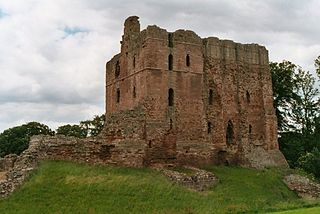
Sir Thomas Grey or Gray of Heaton Castle in the parish of Cornhill-on-Tweed, Northumberland, was the son of Sir Thomas Grey, an eminent soldier in the Anglo-Scottish wars in the reigns of Edward I and Edward II, and his wife, Agnes de Bayles. He was the author of the English chronicle, the Scalacronica.
The Capitulation of Irvine was an early armed conflict of the Wars of Scottish Independence which took place on 7 June 1297. Due to dissension among the Scottish leadership, it resulted in a stand-off.
The Actes and Deidis of the Illustre and Vallyeant Campioun Schir William Wallace, also known as The Wallace, is a long "romantic biographical" poem by the fifteenth-century Scottish makar of the name Blind Harry, probably at some time in the decade before 1488. As the title suggests, it commemorates and eulogises the life and actions of the Scottish freedom fighter William Wallace who lived a century and a half earlier. The poem is historically inaccurate, and mentions several events that never happened. For several hundred years following its publication, The Wallace was the second most popular book in Scotland after the Bible.
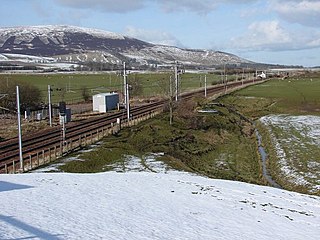
Lamington is a conservation village in South Lanarkshire in Scotland, roughly between Biggar and Lanark and sits astride the A702 trunk road.
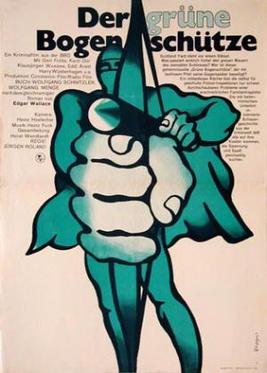
The Green Archer is a 1961 West German black and white crime film directed by Jürgen Roland and starring Gert Fröbe, Klausjürgen Wussow, Karin Dor and Eddi Arent. It is based on the 1923 novel The Green Archer by Edgar Wallace.
William Wallace Hozier, 1st Baron Newlands, known as Sir William Hozier, Bt, between 1890 and 1898, was a Scottish soldier and businessman.
The Barns of Ayr was, according to Blind Harry in The Wallace, a site in Ayr, Scotland, which was used as English barracks. According to Blind Harry, a number of Scottish barons of Ayrshire were called to a meeting with King Edward I of England at a barn used as an English military barracks, only to be massacred and hanged, including Sir Ronald Crawford Sheriff of Ayr, Sir Bryce Blair of Blair, Sir Neil Montgomerie of Cassillis, Crystal of Seton, and Sir Hugh Montgomerie. In revenge, William Wallace burned the barracks with the English inside.

The Bickering bush (NS41863635) thorn grew near Caprington on the lands of Monksholm or Maxholm, Riccarton, East Ayrshire, Scotland. The old farm house at Maxholm sat in hollow on the old Caprington Castle estate and to the north and west its fields bordered the River Irvine. The thorn was located, as recorded on the OS map, near to the confluence of the Kilmarnock Water and the River Irvine, downstream of the Simon's Burn's confluence on the south bank of the river.











